#thinsectionthursdays
Explore tagged Tumblr posts
Text
Intruded Pelite
#ThinsectionThursday A carbonate vein intruding a 3.2 billion year old pelite. Greenish mineral is chlorite, dirty grey brown material is carbonate, pale grey white material is quartz, opaque material is pyrite. 4x Magnification #Geology #Metamorphic
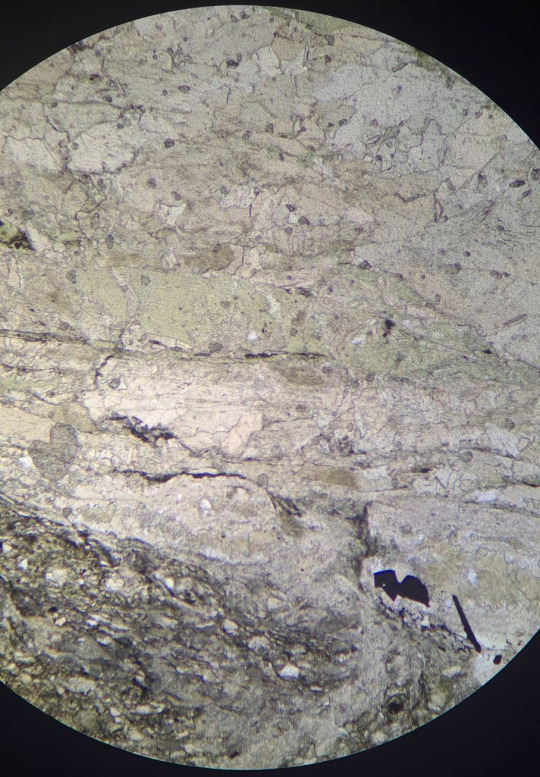
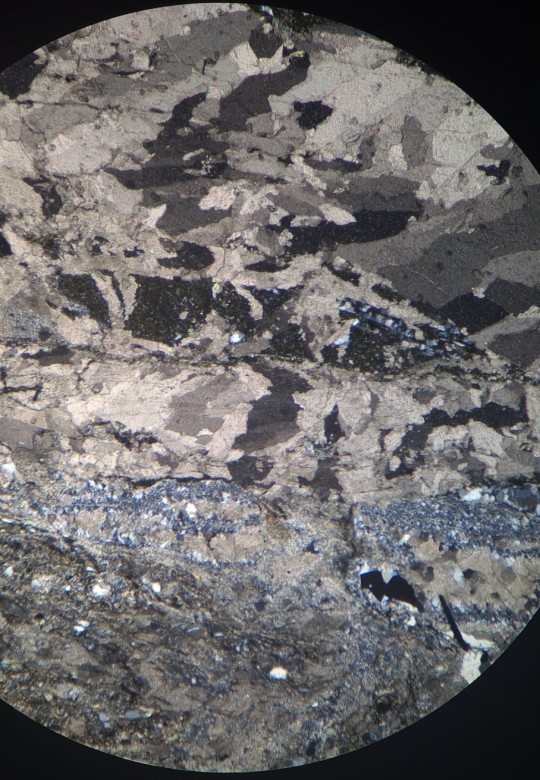
23 notes
·
View notes
Photo

Growth rings in the mineral, just like the rings of the tree trunk show how it grew over time. Mineral plagioclase in the rock gabbro. Image was taken with a petrographic microscope.
#Submission#The Earth Story#Photography#Original Photography#Original Photographers#submission#Thin section#thinsectionthursday#geology
62 notes
·
View notes
Photo

Hi. Here’s a thin section of my favorite rock: peridotite. This is our Earth’s mantle which means we’re basically gliding on microscopic glitter - kinda ✨
3 notes
·
View notes
Photo

Thin section of a granulite in XPL
0 notes
Photo


(It's me)
Happy #thinsectionthursday everyone! :D
This is an opaque mineral in my dolerite samples, as seen in plane-polarized light. With opaque minerals, it’s very difficult to determine what they actually are in thin section. Even at 0.03mm, light doesn’t pass through them, so you can’t use their optical properties (such as birefringence) to identify what they are. A lot of times the best you can do is hold the slide up to the light and see what color the opaques reflect! In this case, I have a good sense of this rock’s composition, which helps me make an educated guess. As a mafic rock, dolerite has more magnesium and iron than its felsic counterparts, so these opaques are most likely an iron oxide (magnetite, likely). In other mafic rocks, a titanium oxide wouldn’t be a bad guess, either, except that whole rock analysis has revealed these rocks to be very titanium-poor. The surrounding minerals are plagioclase (low-relief, relatively colorless) and clinopyroxene, with maaaaybe some olivine in the bottom right of the less-magnified snapshot.
#thin section Thursday#thin sections#petrology#petrography#mineralogy#minerals#geology#science#clinopyroxene#plane polarized light#petrographic analysis#mineral identification#optical mineralogy#funny face#pareidolia#iron oxide#magnetite#mafic rocks
11 notes
·
View notes
Text
Fossil Microbial Mats

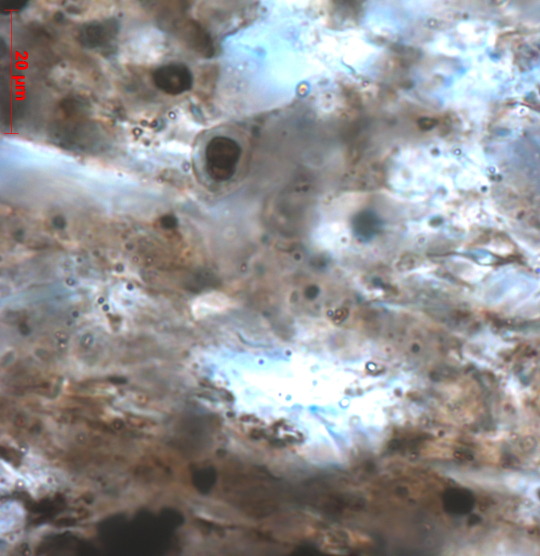
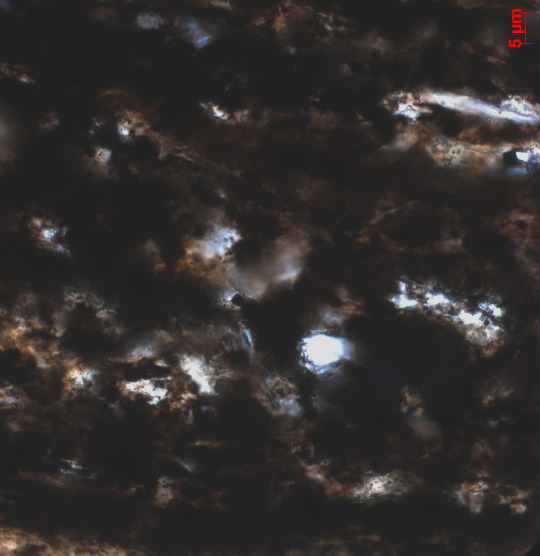
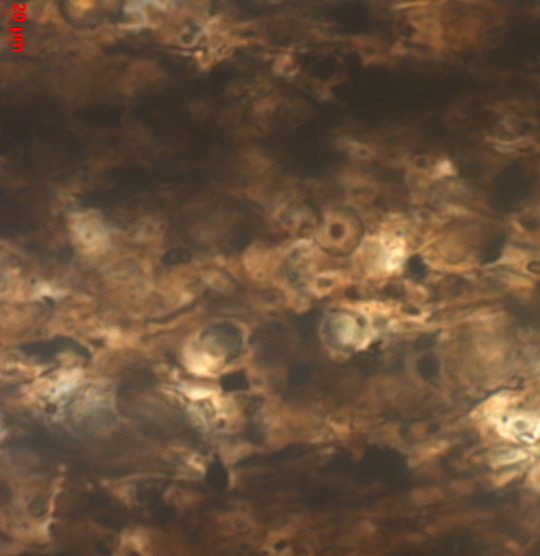
Extreme close ups of 1.3 billion year old microbial mats in muddy OM rich chert. Fossils are the dark filaments and spheres, surrounded by a pale coating of phosphate and silica. Some fossils have been replaced by silica, phosphate, or pyrite. The little spheres and long filamentous structures are the fossil microbes. The scale bar at the side says 20 microns, which is a bit thinner than a human hair. So that gives you an idea of how tiny these microbes where.
Each sphere and filament was a tiny colony of individual microbes. So each sphere and filament is like a tower block full of apartments the microbes lived in, and the mat is like a city.
But these mats were so dense and thick, that if you scaled up one of the fossil microbes to the size of an average human, the mat would be 25 km high and cover all of Europe and most of Asia.
Mats like this covered the floor of Earths shallow seas long before animals and plants evolved. The tops of the mats were photo synthesisers, below them live microbes that could convert sulphur and iron into energy.
These microbial communities worked nonstop for billions of years, changing the chemistry of the Earths oceans and atmosphere, pumping out oxygen, and making the world habitable to more complex life like the first simple animals, and eventually humans.
They were here long before even the simplest animals and plants, and they will be here long after we have gone. Microbial mats like this will probably be some of the last life on Earth, and I wouldn't be surprised if they were common on warm, wet, rocky planets throughout the universe.
#Paleontology#Geology#geologyjohnson#palaeontology#precambrian#fossils#fossil#fossilfriday#acritarch#microbes#Bacteria#Microfossil#thinsectionthursday
23 notes
·
View notes
Text

#ThinsectionThursday and an early #FossilFriday A section through 2 crinoid ossicles from the earliest Jurassic #Redcar Mudstone from Redcar Beach, UK. You can see the joint between ossicles and the stereom texture quite nicely. Brown is OM, black is pyrite.
Microscope photo of a crinoid stem showing it is made from light grey calcite with a bobbly texture called stereom. The plates of the stem are connected via a curving zig zag where rounded ridges on one plate lock into the corresponding grooves of another plate. the upper right of the picture is taken up by light brown organic matter and tiny black squares of pyrite.
#geology#geologyjohnson#palaeontology#jurassic#fossil#fossilfriday#paleontology#crinoid#echinoderm#thinsectionthursday
4 notes
·
View notes
Video
bryanseym Thin section of a garnet schist under cross-polarized light. Rocks are cool.
#thin section#schist#metamorphic#thin section thursday#thinsectionthursday#birefringence#geology#video#petrology#the earth story#garnet#amphibolite
45 notes
·
View notes
Photo

Interference patterns These shimmering colours were snapped through a microscope on the surface of a platy inclusion within a pink spinel crystal from Burma. The lighting is a side mounted fibre optic lamp combined with darkfield, in which the light is diffused from the side into the bottom of the gem. The colours are caused by reflections off cleavage planes within the inclusion, called thin film interference. The image is about a millimetre across. Loz Image credit: Loz
#Science#mineral#spinel#geology#crystal#the earth story#interference colors#thinsectionthursday#burma#myanmar
79 notes
·
View notes
Video
Fossil belemnites under a microscope
#belemnite#fossil#geology#carbonate#calcite#thin section#sedimentary#thinsectionthursday#instagram#the earth story
130 notes
·
View notes
Photo

Natural abstract art. A crystalline intergrowth of pyroxene and plagioclase feldspar in a high grade metamorphic rock resembles a modernist painting magnified five times in cross polarised light. Loz Image credit: Bernardo Cesare
150 notes
·
View notes
Video
Lovely and colorful view of a schist in thin section
#birefringence#geology#mica#metamorphic#thinsectionthursday#video#instagram#the earth story#brown university
305 notes
·
View notes
Video
instagram
Labeled as a muscovite schist - the elongate grains are the mica minerals.
#Muscovite#schist#geology#video#thin section#ThinSectionThursday#thin section thursday#extinct#extinction#the earth story#instagram
198 notes
·
View notes
Video
bluemorphophoto This is what a thin slice of gabbro (a type volcanic rock) looks like under a polarising microscope. Many of the minerals that make up rocks have distinctive properties and these properties can help geologists identify the composition of rocks. When viewed in plane polarised light, many of the common minerals look colourless. However, in crossed polarised light, many minerals exhibit fantastic interference colours and unique properties. The black and white striped minerals here are plagioclase feldspar and they are exhibiting a property called lamellar twinning (the stripes). The bright blue and pink mineral is olivine. :) So much to discover. :)
#Gabbro#geology#igneous#microscope#thin section#thinsectionthursday#Plagioclase#olviine#crystal#mineralogy#the earth story#petrology
65 notes
·
View notes
Video
instagram
Biotite pleochroism - change in color under the microscope when the mineral is rotated (plane polarized light)
#biotite#pleochroism#thin section#thin section thursday#geology#microscope#ThinSectionThursday#video#instagram#rock#the earth story
71 notes
·
View notes
Video
instageology Clorite and muscovite in a thin section. First picture seen in polar light and the second one in nlrmal light.
#Mineral#Mineralogy#Thin section#Thinsectionthursday#geology#Slide#chlorite#muscovite#mica#Serpentine#The earth story
69 notes
·
View notes